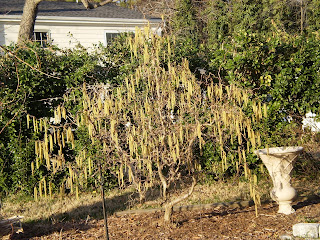 changing in the garden right now. Yesterday the the lilac bloomed - Syringa patula 'Miss Kim'. It is truly a love in the garden. It blooms later than other lilacs, extending their season. It's compact - 6-8 feet at maturity and easily trimmed to stay shorter, so you can use it as a foundation plant. We put it at the foot of the steps from our deck to the yard. The moment you step onto the deck - from the house or from the yard - you get the wonderful fragrance.
changing in the garden right now. Yesterday the the lilac bloomed - Syringa patula 'Miss Kim'. It is truly a love in the garden. It blooms later than other lilacs, extending their season. It's compact - 6-8 feet at maturity and easily trimmed to stay shorter, so you can use it as a foundation plant. We put it at the foot of the steps from our deck to the yard. The moment you step onto the deck - from the house or from the yard - you get the wonderful fragrance. And, it's a beautiful color. The buds are pinker, but the flowers are more ice blue-violet. Oh, and it doesn't mind our climate. A winner all around! This is one of my "memory plants". I planted it in memory of a dear friend's mother.
And, it's a beautiful color. The buds are pinker, but the flowers are more ice blue-violet. Oh, and it doesn't mind our climate. A winner all around! This is one of my "memory plants". I planted it in memory of a dear friend's mother.Another beauty that came into full bloom this week is a weigela - Weigela florida 'Java Red'. It's a smaller variety - not really small enough to be considered a dwarf - but better for smaller spaces. This one is going to get a major pruning after it finishes blooming in the hope of improving its shape. The side that you cannot see is nearly flat because there was a huge clump of sea grass behind it until last fall. I finally decided
 that the sea grass was way too invasive and dug it up, but it had really hurt the shape of this shrub. I hope that by cutting it way back, it will grow out all the way around and even out in the next couple of years.
that the sea grass was way too invasive and dug it up, but it had really hurt the shape of this shrub. I hope that by cutting it way back, it will grow out all the way around and even out in the next couple of years.And, then if you truly want to see what an early spring we have had, here's my best proof.
A water lily bloomed this week! This is one that Mother gave me a couple of years ago. We didn't have room for it in the fish pond, so we got a small pond liner and created a lily (only) pond. I don't give it an annual cleaning (since fish are not dependent on it), so I don't cut back the plant in the fall, and the result is this! Turns out the frogs have the prettiest spot in the garden right now!

More Change in the Air.
In the spirit of spring, I have decided to make a change in my blogging, too. For about 18 months I have maintained two sites - this one which has been wholly about the garden and my first site - From the Garden Bench - which was planned to be insightful comments on my life and the world. I find that I have much more to say about the garden, and this topic is the one that draws me most of the time, but I still want to write about other things from time to time - without needing to maintain a presence at both locations. So, starting May 1st I shall combine the two blogs - but over at the other site. This one will remain up in case anyone is just dying to look up something in an old post - and so I can link back to it - but all the new stuff will be other "there". And, gardening will still be the main focus of what I write.
I will leave a link here, but hope you will come find me next month "on the bench" as well as "in the garden".

















































